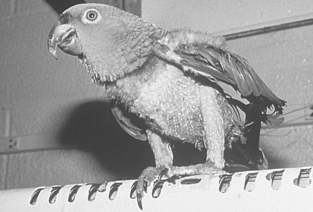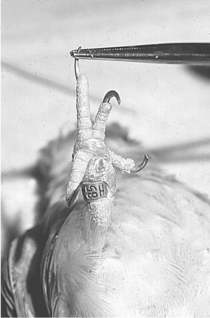Chapter 31 Diseases of the Integumentary System
The avian skin is much thinner and more easily damaged than that of mammals. The layers of the skin (epidermis, dermis, and subcuticular) are the same as in other animals. The horny bill is composed of hard keratinized epithelium and the underlying dermis that is continuous with the periosteum of the mandible and premaxilla. The beak contains sensory receptors that provide for food discrimination and tactile sensation. Claws are also extensions of the hard keratinized epithelium. Some species of birds have a uropygial gland that produces an oily substance for waterproofing of the feathers (African gray parrots and budgies have this gland whereas Amazon parrots do not). This gland can become obstructed and cause a swelling above the tail head in some birds.
DISEASES THAT INVOLVE THE FEATHERS
Feather Mutilations
Feather picking, plucking, and chewing are common problems seen in the veterinary clinic (Fig. 31-1). They are also some of the most frustrating and difficult problems to treat. It is believed that some of these behaviors may develop from boredom and excessive grooming behavior that gets out of hand (similar to cage walking and other captive behavior problems seen in mammals). In some species—the passerines—feather plucking can be related to aggression, with male birds plucking female or other subservient male birds. In psittacines, feather mutilations appear to be more complex in nature. Feather picking should be suspected in birds that have normal head feathers with varying degrees of body feather loss or damage. The African gray appears to be involved in feather mutilation more frequently than Amazon or Macaw parrots.

Figure 31-1 Amazon parrot with severe feather picking.
(From Altman RB, Clubb SL, Dorrestein GM, Quesenberry KE: Avian medicine and surgery, Philadelphia, 1997, WB Saunders, by permission.)
SKIN ABNORMALITIES
Bumblefoot (Pododermatitis)
Bumblefoot is a common problem in captive, heavy-bodied birds, particularly cockatiels, budgies, and Amazon parrots (Fig. 31-2). Development of the infection is secondary to trauma to the plantar surfaces of the feet.

Figure 31-2 Bumblefoot lesion in an obese parakeet maintained on improper perches.
(From Altman RB, Clubb SL, Dorrestein GM, Quesenberry KE: Avian medicine and surgery, Philadelphia, 1997, WB Saunders, by permission.)



